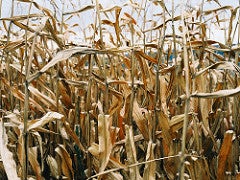
Photo Credit: Flickr user Benjamin Disinger (License)
Here’s a statement that everyone can agree on, regardless of politics: Farmers benefit from making their croplands more resilient to the effects of extreme weather.
Report after report, including a study this week in the journal Nature Geoscience, has shown that shifting climatic conditions will hit agriculture hard, threatening food supplies and farmers’ incomes. This week’s report found that in years when the Arctic was warmer than normal, the average decline in yields across the United States was as high as 4 percent – and in Texas, corn yields were as low as 20 percent of what they are in typical years.
Farmers can take steps to protect their operations from extreme weather – but they can’t do it alone.
The 2018 farm bill can and should play a powerful role in helping farmers adapt to changing climatic conditions by prioritizing and supporting public-private partnerships, innovation, and financial models that can accelerate deployment of conservation practices.
Collaborative conservation
By increasing the reach and sustained impact of USDA conservation programs, farmers will be better prepared to face the effects of climactic changes.
Federal policies alone are not enough to protect farmers or the natural resources on which they depend. If governments, food companies, ag retailers, and agribusinesses continue to work on parallel tracks, we will waste valuable time and resources that could be better spent directly helping farmers become more resilient.
By addressing some needed improvements to the Regional Conservation Partnership Program (RCPP), we can create powerful public-private partnerships that deliver measurable results at scale – and that make the best use of taxpayer dollars. These changes include:
- Re-focusing RCPP on multi-partner, public-private projects working in high-priority watersheds. Projects should target funding to optimize climate-smart agriculture practices while also identifying specific environmental outcomes.
- Increasing overall funding levels for RCPP and allowing donor program contributions to RCPP to be used for collaborative projects.
[Tweet “3 ways the farm bill can protect croplands from extreme weather, via @GrowingReturnshttps://edf.org/8Qv”]
Innovation

Photo Credit: Adapt-N
USDA conservation programs, administered through the Natural Resources Conservation Service (NRCS), need to keep up with the kinds of innovation that farmers have embraced for decades. These innovations – which include seeds, mapping, variable rate application of nutrients, enhanced efficiency fertilizers, and crop diversity – not only improve productivity but help farms weather intense periods of drought, rainfall and temperature abnormalities.
Unfortunately, NRCS suffers from a cumbersome and unclear decision-making processes that hinders adoption of technology and scientifically sound conservation practices.
The farm bill can help by:
- Redirecting NRCS to focus on its strength: providing technical assistance to private landowners to conserve natural resources on agricultural land.
- Requiring a more predictable and transparent process for NRCS to evaluate new and current conservation practice standards within a reasonable time period.
New financial models
Farmers get paid based on yield, but their balance sheets typically ignore the financial hits caused by unpredictable weather, or the benefits that stewardship efforts provide for the environment.
Federal programs aimed at helping farmers implement conservation practices do not currently assess outcomes. Without measurable results, federal programs risk paying for intentions, not for activities that will increase the resiliency of farmland across the country.
Changes to farm bill programs can help ensure that farmers and natural resources are benefiting from these programs; changes include:
- Directing USDA’s Risk Management Agency to implement “Practice Codes” for crop rotation, cover cropping, and conservation tillage – practices that will increase soil health and reduce erosion that often accompanies flooding events.
- Eliminating the existing Conservation Reserve Program and Conservation Reserve Enhancement Program limitations that hinder resiliency efforts, and encouraging USDA to support practices like saturated buffers and bioreactors that protect croplands.
By increasing the reach and sustained impact of USDA conservation programs, farmers will be better prepared to face the effects of climactic changes.
This blog originally appeared on AgWeb.com.










One Comment
How can we increase farmer adoption rates? I’ve seen farmers turning away NRCS support for conservation practices, because they don’t want the government involved in their business. But they don’t seem reluctant to share data and relinquish power to the Big Ag through their choice of input suppliers and production model- not that the latter is a problem, but the issue of resistance to public incentive is!
What is the right equation?